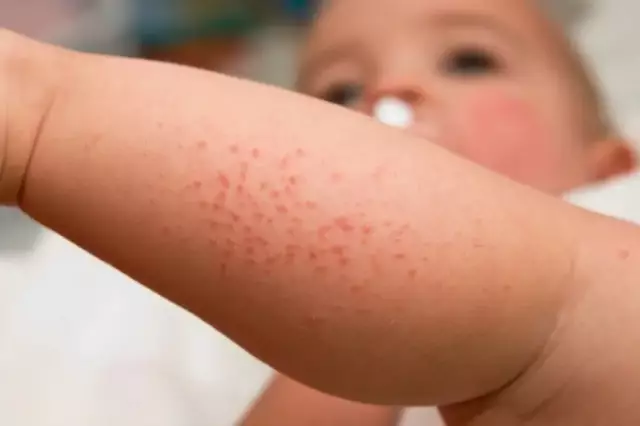- Author Rachel Wainwright [email protected].
- Public 2023-12-15 07:39.
- Last modified 2025-11-02 20:14.
Laryngotracheitis in children
The content of the article:
- Causes of laryngotracheitis in children and risk factors
- Forms of the disease
-
Symptoms of laryngotracheitis in children
- Acute laryngotracheitis
- Chronic laryngotracheitis
- Diagnostics
- Treatment of laryngotracheitis in children
- Possible consequences and complications of laryngotracheitis in children
- Forecast
- Prevention
Laryngotracheitis in children is an inflammatory disease of predominantly viral or bacterial etiology, in which the inflammatory process spreads to the larynx and trachea.

Source: malutka.pro
The peculiarities of immunity in children, as well as the relatively short length of the airways, contribute to a greater predisposition of children to this disease. In childhood, the infectious and inflammatory process that began in the nasopharynx, especially often tends to go lower, while the larynx is affected, and then the trachea. In children under six years of age, due to anatomical features, against the background of laryngotracheitis, a narrowing of the lumen of the larynx may occur, which causes respiratory failure - the so-called false croup develops, which carries a potential threat to life. Another name for this condition is stenosing laryngotracheitis.
Causes of laryngotracheitis in children and risk factors
The cause of laryngotracheitis in children is infection with viruses and / or bacteria, most often viruses act as an infectious agent. Infection occurs by airborne droplets from a sick person. In most cases, laryngotracheitis develops against the background of acute respiratory diseases: adenovirus infection, parainfluenza, influenza, measles, rubella, chickenpox, scarlet fever.
Laryngotracheitis of bacterial etiology can occur when infected with staphylococci, streptococci, pneumococci, mycobacterium tuberculosis, mycoplasma, treponema pale, chlamydia.
Laryngotracheitis in children often develops as a complication of sinusitis, laryngitis, pharyngitis, tonsillitis, adenoiditis.
Risk factors for the disease, as well as its transition to a chronic form, include:
- immunodeficiency states;
- constant breathing through the mouth (in violation of nasal breathing against the background of curvature of the nasal septum, allergic rhinitis, sinusitis, choanal atresia);
- chronic somatic diseases (hepatitis, gastritis, pyelonephritis, glomerulonephritis, etc.);
- hypothermia;
- metabolic disorders;
- poor nutrition;
- too hot or cold, excessively dry or humid inhaled air;
- passive smoking.
Forms of the disease
Laryngotracheitis in children can be acute (uncomplicated and stenosing) and chronic. Chronic, depending on the morphological changes in the mucous membrane, is divided into catarrhal, hypertrophic and atrophic forms. Acute laryngotracheitis in children is much more common.
According to the etiological factor, viral, bacterial and mixed forms of laryngotracheitis are distinguished.
Symptoms of laryngotracheitis in children
Acute laryngotracheitis
Clinical manifestations of acute laryngotracheitis in children usually occur against the background of already existing symptoms of an acute infectious disease of the upper respiratory tract (discharge from the nasal cavity, nasal congestion, sore throat or sore throat, discomfort when swallowing, fever). At the same time, the symptoms of laryngotracheitis in children appear after the patient's body temperature drops to subfebrile values - after improvement, the child's condition worsens again.
Children with acute laryngotracheitis develop hoarseness, discomfort in the larynx (dryness, burning, tickling, foreign body sensation), dry cough, followed by chest pain. Cough is usually observed in the morning and at night, it can manifest itself as an attack against the background of inhaling cold or dusty air, taking a deep breath, crying, laughing. At the same time, a small amount of mucous sputum is released, which, when a secondary bacterial infection (or bacterial laryngitis) is attached, becomes mucopurulent.
Acute laryngotracheitis in children is often accompanied by an increase in cervical lymph nodes. As a rule, they increase on both sides, painful on palpation.

On examination, marked hyperemia and thickening of the mucous membranes in the affected area. Bacterial laryngotracheitis is characterized by the accumulation of purulent exudate in the lumen of the larynx and trachea. At the initial stage of the disease, the pathological discharge has a liquid consistency, as the pathological process progresses, the exudate becomes thicker, fibrinous films appear on the mucous membranes. In the case of staphylococcal or streptococcal etiology of laryngotracheitis, yellow-green crusts are formed that fill the lumen of the respiratory tract.
Stenosing laryngotracheitis is characterized by swelling of the affected mucous membranes, a pronounced narrowing of the lumen of the larynx, which impedes the movement of air, noisy inhalation and exhalation (dry wheezing rales can be heard during inhalation - the so-called stridor breathing), dyspnea attacks, tachycardia.
Chronic laryngotracheitis
With the catarrhal form of chronic laryngotracheitis in children, hyperemia of the affected mucous membranes with a cyanotic tinge, dilatation of submucous blood vessels, petechial hemorrhages in the submucosal layer, arising due to increased vascular permeability, are observed.
In the case of the development of a chronic hypertrophic form of the disease, hyperplasia of the epithelium of the affected mucous membranes, connective tissue elements of the mucous glands and submucous layer, as well as infiltration of fibers of the internal muscles of the larynx and trachea (including the muscles of the vocal cords) is noted. In this form of the disease, the thickening of the vocal cords can be limited, in the form of nodules, or diffuse, it is also possible to form cysts, contact ulcers of the larynx or prolapse of the ventricle of the larynx.
In chronic atrophic laryngotracheitis (the most rare form of laryngotracheitis in children), the cylindrical ciliated epithelium of the mucous membrane is replaced by keratinizing, atrophy of the intra-laryngeal muscles and mucous glands, hardening of the connective tissue cellular elements of the submucosal layer, thinning of the vocal cords. The walls of the larynx and trachea are often covered with crusts that form when the secretion of the mucous glands dries.
Voice disturbances in chronic laryngotracheitis range from slight hoarseness, which occurs mainly in the morning and evening, to constant hoarseness, and sometimes complete aphonia. In chronic laryngotracheitis in children, the cough is constant, which can cause sleep disorders in such patients. The amount of sputum in this form of the disease, as a rule, increases.
Exacerbations in the chronic form of laryngotracheitis in children are most often observed in the autumn-winter period.
Diagnostics
For the diagnosis of laryngotracheitis in children, complaints and anamnesis are collected, and a physical examination is performed. If necessary, the diagnosis is confirmed by instrumental and laboratory tests.
Identification of an infectious agent in laryngotracheitis in children can be carried out by conducting a bacteriological examination of sputum and discharge from the pharynx and nose, microscopy of sputum, as well as enzyme-linked immunosorbent assay, immunofluorescence reaction, polymerase chain reaction. In case of detection of mycobacterium tuberculosis, it is necessary to consult a phthisiatrician.
In difficult diagnostic cases, microlaryngoscopy may be required, which makes it possible, if necessary, to take material for a biopsy.
In chronic laryngotracheitis (especially when hypertrophic changes are detected), it may be necessary to use frontal computed tomography of the larynx, endoscopic biopsy. Based on the results of these studies, an oncologist's consultation may be required.
In order to identify possible bronchopulmonary complications, an X-ray examination of the lungs is performed.
Differential diagnosis of laryngotracheitis in children with foreign bodies of the larynx and trachea, diphtheria, bronchial asthma, retropharyngeal abscess, malignant neoplasms is required.
Treatment of laryngotracheitis in children
Treatment of laryngotracheitis in children, as a rule, is carried out on an outpatient basis, in the event of the development of false croup, the patient is hospitalized in a hospital.
Antihistamines, antitussives, mucolytic drugs are prescribed. With an increase in body temperature, antipyretic drugs are prescribed. Shown are alkaline and / or oil inhalations, nebulizer therapy, electrophoresis in the larynx and trachea.

Source: gajmorit.com
Drug therapy of bacterial laryngotracheitis consists in the use of anti-infectious drugs, the selection of which is carried out depending on the type of pathogen and taking into account its sensitivity.
Treatment of the chronic form of laryngotracheitis in children is complemented by the appointment of vitamin complexes, immunomodulatory therapy, physiotherapy (ultra-high-frequency therapy, inductometry), as well as massage.
Surgery may be indicated if complications develop, such as a pharyngeal abscess or laryngeal cyst.
The main treatment of laryngotracheitis in children can be supplemented with herbal medicine (preparations of eucalyptus, sage, chamomile in the form of rinsing or inhalation). Given the high allergenicity of herbal medicines, they should be used only in consultation with the attending physician.
Children with an acute form of the disease or exacerbation of a chronic one are shown an abundant drinking regime (warm tea, compote, jelly), as well as a sparing diet, balanced in composition, with the exception of products that irritate the mucous membrane (sour, spicy, hot, cold dishes). The air in the room where the patient is located should be fresh and sufficiently humid.
Possible consequences and complications of laryngotracheitis in children
Complications of laryngotracheitis in children include the spread of the pathological process to other parts of the respiratory tract with the development of tracheobronchitis and pneumonia, bronchiolitis, neoplasms of the larynx or trachea.
Against the background of false croup, a patient with laryngotracheitis may develop asphyxia.
Forecast
With timely adequate treatment of acute uncomplicated laryngotracheitis, the prognosis is favorable. If complications develop and the disease becomes chronic, the prognosis worsens. Asphyxia can be fatal.
Prevention
In order to prevent the development of laryngotracheitis in children, it is recommended:
- timely and adequate treatment of infectious diseases, especially acute respiratory viral infections (ARVI);
- avoiding hypothermia;
- adequate physical activity;
- regular walks in the fresh air;
- rational daily routine;
- balanced diet;
- hardening;
- quitting smoking in the presence of a child.
YouTube video related to the article:

Anna Aksenova Medical journalist About the author
Education: 2004-2007 "First Kiev Medical College" specialty "Laboratory Diagnostics".
The information is generalized and provided for informational purposes only. At the first sign of illness, see your doctor. Self-medication is hazardous to health!






